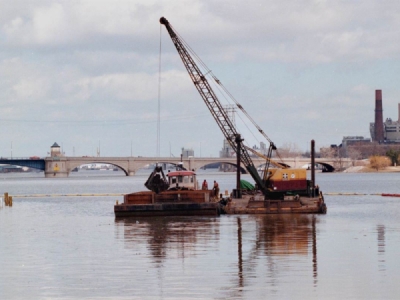
Posted on July 22, 2020
Federal contractors remove hundreds of thousands of cubic yards of soil and sand each year from the Toledo Harbor shipping channel to keep it deep enough for freighters plying the Great lakes to get to and from local docks.
But when Ryba Marine Construction of Cheboygan, Mich., starts work in September on this year’s $2.1 million contract from the U.S. Army Corps of Engineers, it won’t be dumping the roughly 400,000 cubic yards of dredged silt in Lake Erie’s open waters, as has been done with much larger volumes since the 1980s.
Instead, the contract the Corps awarded July 1 calls for the material “to be placed in a contractor-furnished location.”
Joe Cappel, Toledo-Lucas County Port Authority vice president of business development, said that means the port-owned Facility 3 disposal site on a man-made island at the Maumee River’s mouth.
That will put the dredging campaign in compliance with an Ohio law, effective July 1, that forbids open-lake silt dumping in state waters.
The law, though, allows the Corps to seek waivers annually.
Facility 3 has for many years received silt dredged from ship berths at various docks in Toledo’s port.
Many Great Lakes scientists, as well as environmental activists, have decried open-lake dumping, arguing that it interferes with fish spawning in Maumee Bay and potentially worsens summer algal blooms there, in the Maumee, and in western Lake Erie by releasing sequestered algae nutrients.
Governors of both parties have opposed the longstanding Corps practice, as have state of Michigan officials.
But the Corps, with at least one major study in recent years which defended the practice, has insisted that open-lake disposal of material from the main channel is compliant with the federal Clean Water Act.
The U.S. Environmental Protection Agency, which enforces that act, has said it regulates the impact of silt on fisheries and water quality only for chemical concentration, not the potential cumulative effect of large volumes.
Former Gov. John Kasich signed the dumping ban into law in 2015, one year after Toledo’s algae-induced water crisis prompted health officials to warn the people against drinking or using the city’s tap water for parts of three days the first weekend of August, 2014.
The port authority subsequently spent $1.2 million to shore up Facility 3’s dike wall, then early last year received a $1.9 million state grant to expand the disposal site’s capacity.
“This year, for the first time, we have the space for it,” Mr. Cappel said.
The expansion project, he said, provides between six and 10 years’ additional capacity. It buys more time for ongoing research to develop beneficial reuses of the silt, efforts which have been under way for years.
The Toledo Ship Channel stretches more than 22 miles from western Lake Erie to the Maumee River’s head of commercial navigation at the grain and aggregates terminals near I-75’s DiSalle Bridge.
While it’s intended to be 28 feet deep to the Maumee’s mouth, and 25 to 27 feet deep upstream of there, soil and sand carried downstream in the river continually creates shoals to much shallower depths that threaten ships’ access to terminals that handle coal, iron ore, grain, stone, petroleum products, and a variety of other cargoes.
“Dredging the Toledo Harbor 9 is crucial to supporting thousands of local and regional jobs as well as shipping more than 9 million tons of material per year,” U.S. Sen. Rob Portman (R., Ohio), said.
Regular channel maintenance is vital to the port’s function, U.S. Rep. Marcy Kaptur (D., Toledo) agreed, and said on-shore silt disposal this year is “a more environmentally sustainable solution” to that aspect of the work.
Although the Corps of Engineers maintains channels in seven other Ohio ports, Toledo accounts for about two thirds of all material dredged from those ports.
“We look forward to continued collaboration on dredging across the state of Ohio to not only secure navigation and commerce, but also secure the environmental health of beautiful places like Maumee Bay and Lake Erie,” Lt. Col. Eli Adams, commander of the Army corps’ Buffalo District, said.
Toledo’s shipping channel is the most heavily dredged in the Great Lakes region.
In many previous years, when water levels were lower, the Corps had contracts to dredge 800,000 to 1.2 million cubic feet of silt each summer, roughly enough to fill downtown Toledo’s tallest skyscraper three times.
Many Great Lakes water levels, including Lake Erie’s, have been at or near record levels the past few years.
Source: toledoblade





